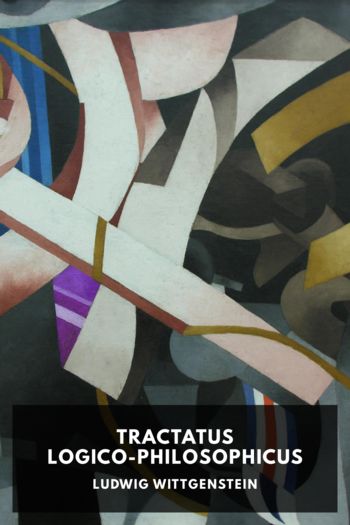Tractatus Logico-Philosophicus, Ludwig Wittgenstein [top inspirational books .txt] 📗

- Author: Ludwig Wittgenstein
Book online «Tractatus Logico-Philosophicus, Ludwig Wittgenstein [top inspirational books .txt] 📗». Author Ludwig Wittgenstein
What values the propositional variable can assume is determined.
The determination of the values is the variable.
3.317The determination of the values of the propositional variable is done by indicating the propositions whose common mark the variable is.
The determination is a description of these propositions.
The determination will therefore deal only with symbols not with their meaning.
And only this is essential to the determination, that it is only a description of symbols and asserts nothing about what is symbolized.
The way in which we describe the propositions is not essential.
3.318I conceive the proposition—like Frege and Russell—as a function of the expressions contained in it.
3.32The sign is the part of the symbol perceptible by the senses.
3.321Two different symbols can therefore have the sign (the written sign or the sound sign) in common—they then signify in different ways.
3.322It can never indicate the common characteristic of two objects that we symbolize them with the same signs but by different methods of symbolizing. For the sign is arbitrary. We could therefore equally well choose two different signs and where then would be what was common in the symbolization?
3.323In the language of everyday life it very often happens that the same word signifies in two different ways—and therefore belongs to two different symbols—or that two words, which signify in different ways, are apparently applied in the same way in the proposition.
Thus the word “is” appears as the copula, as the sign of equality, and as the expression of existence; “to exist” as an intransitive verb like “to go”; “identical” as an adjective; we speak of something but also of the fact of something happening.
3.324Thus there easily arise the most fundamental confusions (of which the whole of philosophy is full).
3.325In order to avoid these errors, we must employ a symbolism which excludes them, by not applying the same sign in different symbols and by not applying signs in the same way which signify in different ways. A symbolism, that is to say, which obeys the rules of logical grammar—of logical syntax.
(The logical symbolism of Frege and Russell is such a language, which, however, does still not exclude all errors.)
3.326In order to recognize the symbol in the sign we must consider the significant use.
3.327The sign determines a logical form only together with its logical syntactic application.
3.328If a sign is not necessary then it is meaningless. That is the meaning of Occam’s razor.
(If everything in the symbolism works as though a sign had meaning, then it has meaning.)
3.33In logical syntax the meaning of a sign ought never to play a role; it must admit of being established without mention being thereby made of the meaning of a sign; it ought to presuppose only the description of the expressions.
3.331From this observation we get a further view—into Russell’s “Theory of Types.” Russell’s error is shown by the fact that in drawing up his symbolic rules he has to speak about the things his signs mean.
3.332No proposition can say anything about itself, because the propositional sign cannot be contained in itself (that is the “whole theory of types”).
3.333A function cannot be its own argument, because the functional sign already contains the prototype of its own argument and it cannot contain itself.
If, for example, we suppose that the function F(fx) could be its own argument, then there would be a proposition “F(F(fx))”, and in this the outer function F and the inner function F must have different meanings; for the inner has the form φ(fx), the outer the form ψ(φ(fx)). Common to both functions is only the letter “F”, which by itself signifies nothing.
This is at once clear, if instead of “F(Fu)” we write “(∃φ):F(φu).φu=Fu”.
Herewith Russell’s paradox vanishes.
3.334The rules of logical syntax must follow of themselves, if we only know how every single sign signifies.
3.34A proposition possesses essential and accidental features.
Accidental are the features which are due to a particular way of producing the propositional sign. Essential are those which alone enable the proposition to express its sense.
3.341The essential in a proposition is therefore that which is common to all propositions which can express the same sense.
And in the same way in general the essential in a symbol is that which all symbols which can fulfill the same purpose have in common.
3.3411One could therefore say the real name is that which all symbols, which signify an object, have in common. It would then follow, step by step, that no sort of composition was essential for a name.
3.342In our notations there is indeed something arbitrary, but this is not arbitrary, namely that if we have determined anything arbitrarily, then something else must be the case. (This results from the essence of the notation.)
3.3421A particular method of symbolizing may be unimportant, but it is always important that this is a possible method of symbolizing. And this happens as a rule in philosophy: The single thing proves over and over again to be





Comments (0)